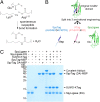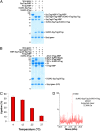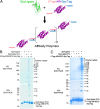SpyLigase peptide-peptide ligation polymerizes affibodies to enhance magnetic cancer cell capture
- PMID: 24639550
- PMCID: PMC3977242
- DOI: 10.1073/pnas.1315776111
SpyLigase peptide-peptide ligation polymerizes affibodies to enhance magnetic cancer cell capture
Abstract
Individual proteins can now often be modified with atomic precision, but there are still major obstacles to connecting proteins into larger assemblies. To direct protein assembly, ideally, peptide tags would be used, providing the minimal perturbation to protein function. However, binding to peptides is generally weak, so assemblies are unstable over time and disassemble with force or harsh conditions. We have recently developed an irreversible protein-peptide interaction (SpyTag/SpyCatcher), based on a protein domain from Streptococcus pyogenes, that locks itself together via spontaneous isopeptide bond formation. Here we develop irreversible peptide-peptide interaction, through redesign of this domain and genetic dissection into three parts: a protein domain termed SpyLigase, which now ligates two peptide tags to each other. All components expressed efficiently in Escherichia coli and peptide tags were reactive at the N terminus, at the C terminus, or at internal sites. Peptide-peptide ligation enabled covalent and site-specific polymerization of affibodies or antibodies against the tumor markers epidermal growth factor receptor (EGFR) and HER2. Magnetic capture of circulating tumor cells (CTCs) is one of the most promising approaches to improve cancer prognosis and management, but CTC capture is limited by inefficient recovery of cells expressing low levels of tumor antigen. SpyLigase-assembled protein polymers made possible the isolation of cancerous cells expressing lower levels of tumor antigen and should have general application in enhancing molecular capture.
Keywords: antibody; bionanotechnology; metastasis; nanobiotechnology; synthetic biology.
Conflict of interest statement
Conflict of interest statement: M.H. is an author on a patent application regarding SpyCatcher technology (United Kingdom patent application no. 1002362.0).
Figures




References
-
- Jarvik JW, Telmer CA. Epitope tagging. Annu Rev Genet. 1998;32:601–618. - PubMed
-
- Huh WK, et al. Global analysis of protein localization in budding yeast. Nature. 2003;425(6959):686–691. - PubMed
-
- Guignet EG, Segura JM, Hovius R, Vogel H. Repetitive reversible labeling of proteins at polyhistidine sequences for single-molecule imaging in live cells. ChemPhysChem. 2007;8(8):1221–1227. - PubMed
-
- Stanfield RL, Wilson IA. Protein-peptide interactions. Curr Opin Struct Biol. 1995;5(1):103–113. - PubMed
Publication types
MeSH terms
Substances
Grants and funding
LinkOut - more resources
Full Text Sources
Other Literature Sources
Research Materials
Miscellaneous

